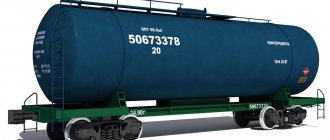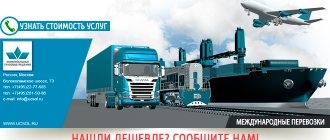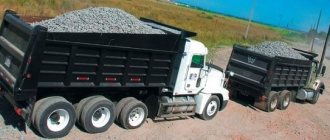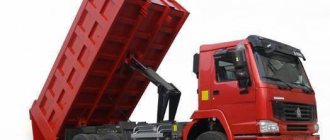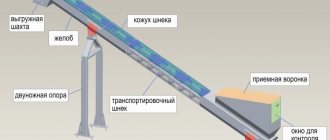A railway tank is a type of rolling stock designed to transport various liquids.
The main cargoes transported by railway tanks are: oil and its products, chemically active and aggressive liquid substances (alkalies, acids, etc.), liquefied gases (propane, butane, methane, etc.), water, milk, juices , alcohols, alcohol-containing liquids, as well as various fine powders: flour, cement, talc, etc. The weight of the cargo transported in the tank is determined by weighing or measuring. When measuring, the loading height is measured and the volume of the loaded cargo is determined using special calibration tables. It should be noted that the weight of petroleum products is determined only by measurement, food cargo - by weighing on carriage scales, and in their absence, on commodity scales. When determining the weight by measurement, the shipper is required to indicate the loading height. temperature and density of the product.
Tank car design
The body of a railway car is a cylindrical container, closed on the sides by elliptical bottoms. Tank containers have various loading/unloading devices, which vary depending on the cargo being transported. Also, depending on the cargo being transported, tank cars may have a thermal insulation coating, equipment for heating the transported cargo, as well as equipment for monitoring the condition of the cargo. In railway tanks with a frame structure, the loads arising during the movement of the train are carried by the supporting frame; in frameless tanks, the function of the supporting frame is performed by the tanks themselves. Additionally, to increase the strength and rigidity of the containers of railway tanks of large diameter and length, the containers can be reinforced with frame rings on the outer or inner surface.
Main types of tanks for transportation of liquid cargo
Transport characteristics of liquid cargo
Liquid cargo includes liquid cargo transported in tanks, containers and gondola cars.
The bulk (more than 90%) of liquid cargo transported by rail consists of petroleum products (kerosene, gasoline, diesel fuel, naphtha, fuel oil, mineral oils, etc.), to a lesser extent - crude oil, which is transported mainly through pipelines. In addition, the category of liquid cargo includes food industry products (vegetable oils, alcohol, molasses, animal fat, lard, etc.), as well as chemical cargo (acids, alkalis, dyes, varnishes, liquefied gases, etc.). Depending on the impact on the environment and human life, all liquid cargo is divided into dangerous and non-hazardous. Non-dangerous goods are transported on a general basis, and when transporting dangerous goods, in addition to the general rules and regulations, it is necessary to comply with special requirements to ensure safe transportation specified in the Rules for the Transportation of Dangerous Goods by Rail.
Liquid cargoes, depending on their properties and purpose, are combined into three main groups:
- oil and petroleum products;
- chemical cargo (acids, alkalis, liquefied gases);
- food products (vegetable oils, alcohols, molasses).
Petroleum products. Types and purpose
All petroleum products can be divided into five groups:
- raw oil;
- dark petroleum products (fuel oil and motor fuel);
- light petroleum products (diesel fuel, kerosene and jet fuel);
- gasoline (automotive and aviation);
- oils (from greases to transformer oils).
Oil cargoes have specific properties that determine the nature of their loading, transportation and storage. These are density, viscosity and the ability to harden not only at negative but also at positive temperatures, easy flammability and evaporation, explosiveness, electrification (accumulation of dangerous charges of static electricity) and toxicity. The use of the tanks' carrying capacity depends on the density. Fuel oil (935 kg/m3) and motor-tractor oil (930 kg/m3) have the highest density.
Properties of liquid cargo
Viscosity is the property of a liquid to resist the movement of its particles under the influence of forces acting on them. The highest viscosity is inherent in most dark petroleum products.
The pour point is the temperature at which the petroleum product loses its mobility (thickens) and does not change its surface when the vessel is tilted.
Density, viscosity and the ability to harden at low temperatures affect the filling and draining processes. Some liquid cargoes freeze even at temperatures above +20 °C (for example, tar +45 °C, petroleum tar +40 °C, petroleum bitumen +28 °C). Under normal conditions, in order to be drained, they must be preheated or transported in specialized tanks and gondola cars.
The volatility of oil cargoes is explained by the presence of a significant amount of volatile substances in them; The intensity of evaporation depends on the temperature of the cargo and air, the evaporation surface, atmospheric pressure and time of year.
The flash point is the lowest temperature at which petroleum product vapors form a mixture with the surrounding air that can ignite when an open flame is applied to it. Based on flash point, all oil cargoes are divided into four classes:
- first - flash point below 28 ° C (gasoline, naphtha, crude oil);
- the second - from 28 to 45 °C (kerosene, some types of diesel fuel, etc.);
- third - from 45 to 120 °C (some types of diesel fuel, motor fuel, naval fuel oil, etc.);
- fourth - over 120 °C (fuel oil, oils, lubricants, etc.).
Petroleum products whose vapor flash point is:
- up to +60 °C, called flammable (or volatile);
- above 60 °C - flammable (or non-volatile).
- Aviation and motor gasoline have a negative flash point (-34 and -36 °C).
When loading, the temperature of the oil product must be at least 5 °C below the flash point.
Flash point is the lowest temperature to which spontaneous combustion occurs when a liquid, gas, or solid is heated without the use of a spark or flame.
The explosive (flammability) limit is the minimum or maximum content of petroleum product vapors in the air that can explode (ignite) when exposed to a spark, flame, or hot metal objects.
Charges of static electricity accumulate during the pumping of petroleum products through pipelines, and a charge of the opposite sign appears on the surface of the pipeline. To avoid the occurrence of an electrical discharge, the speed of movement of petroleum products through the pipeline should not exceed 12 m/s, and appropriate grounding should be installed.
Oil and petroleum products make up the bulk of the volume of cargo (more than 90%) transported by rail in bulk in tanks and bunker gondola cars. Based on specific properties and characteristics, these cargoes are divided into three subgroups:
- crude oil,
- light petroleum products,
- dark petroleum products.
Crude oil —
flammable oil liquid with a characteristic odor and color, containing paraffin, naphthenic and aromatic hydrocarbons, various organic substances, sulfur and acid-containing compounds. Crude oil is transported from production sites to oil refineries, where, after special production processes taking place at high temperatures, light petroleum products (boiling at temperatures up to 350°C) and dark petroleum products (with a boiling point above 350°C) are obtained. Light petroleum products include: gasoline, kerosene, naphtha, and dark petroleum products include gas oil, fuel oil and fuel oil processing products.
Petroleum products (light and dark) are divided into the following subgroups: fuels, oils, and other products.
Fuel includes : motor gasoline, aviation kerosene, diesel fuel, jet fuel and other types of fuel. The characteristics of motor gasoline and jet fuel are detonation resistance, determined by the octane number; fractional composition; low content of resinous substances and sulfur compounds; high heat of combustion. The most important indicator of diesel fuel is the ability to self-ignite when injected into the combustion chamber, which is characterized by the cetane number. For high-speed diesel fuel, the following properties are essential: viscosity, flash point and ash content.
The group of oils includes: motor oils, industrial lubricating oils, greases, special oils, etc. The main property of lubricating oils is the ability to form an oil film on the surface of rubbing parts, the strength of which depends on the viscosity of the oil, and the viscosity, in turn, on temperature ; In addition, oils must be resistant to oxidation, have anti-corrosion and other specific properties.
The group of other petroleum products includes a wide range of products: solvents, lighting kerosene, petroleum bitumen, tar, petroleum pitch, etc. This group also includes petroleum products that serve as raw materials for the petrochemical and chemical industries.
Liquid chemical cargo
Chemical cargo transported in bulk in tanks includes the following groups of cargo: acids, alkalis, alcohols, gases (compressed and liquefied), as well as dyes, varnishes and other substances.
Acids of various types make up the main share in the volume of transportation of liquid chemical products. They are classified as dangerous goods. Acids can cause severe chemical burns, explosions and other emergencies. In addition, they have oxidizing and corrosive properties and can cause corrosion of the internal metal surfaces of the tank boiler. The conditions for transporting specific types of acids depend on their chemical and physical characteristics. Tanks for the transportation of acids classified as dangerous goods must have appropriate painting and warning stencils.
Sulfuric acid is a colorless, transparent oily liquid that can dissolve metals. It is hygroscopic and can combine with water in any proportions, releasing a large amount of heat. Sulfuric acid is transported only in special tanks. Oleum (sulfuric fuming acid) is transported in special oleum insulated thermos tanks owned by the shipper.
Hydrochloric acid is a dangerous caustic substance that can dissolve metals; its freezing point is lower - 40°C; transported in special rubberized tanks. Inhibited hydrochloric acid is transported in sulfuric acid tanks.
Nitric acid is a product of the oxidation of ammonia, boils at a temperature of +86 ° C, acts on all metals except gold, platinum, titanium, and has a weaker effect on aluminum. Technical nitric acid smokes in air at ordinary temperatures and is a strong oxidizing agent. Nitric acid is transported in tanks with an aluminum inner lining of the tank boiler, which has shields on both sides that protect against accidental leakage of the product.
A mixture of nitric acid and sulfuric acid - melange , is a caustic liquid, transported in special sulfuric acid tanks. The filling temperature should not be higher than + 300C, and in summer conditions no higher than + 400C, it has toxic properties. The concentration and composition of the acid poured into the tank must meet the requirements of current standards.
Alcohols
as cargoes have many properties inherent to light petroleum products: flammability, explosion hazard, ability to accumulate a charge of static electricity, intense evaporation, toxicity, narcotic properties, ability to thermal expansion. Alcohols weakly dissolve oils, bitumen and waxes, but have an excellent effect on many resins and dyes.
Methanol (methyl alcohol) is a flammable, highly toxic, colorless, transparent, highly mobile liquid; boils at a temperature of +66°C, flash point + 6°C; methanol vapors form an explosive mixture with air. Methanol resembles wine alcohol in color, smell and taste, but taking it orally causes poisoning, often with loss of vision and often death; transported accompanied by paramilitary guards. Methyl alcohol is used as a solvent for antifreeze, for the synthesis of chemicals, for the production of formaldehyde and other products. Propyl and butyl alcohols are used for the same purposes.
Technical ethyl alcohol is produced by fermenting wood hydrolyzers or sulfate liquors (cellulose production waste). Ethyl alcohol is used in the production of synthetic rubber, acetic acid, chloroform, gunpowder, synthetic dyes, varnishes, etc.
Natural and associated gases
are an important source of energy and chemical raw materials. Natural gas is produced during the development of gas fields, containing up to 99% methane and a small proportion of impurities (nitrogen, hydrogen sulfide, butane, etc.). Associated gases are obtained during oil production and refining. Depending on the structure of the oil, associated gases contain methane, propane, and ethane in different quantitative ratios. Natural and associated gases are used as fuel and chemical raw materials.
Bulk food products
Food and liquid products are divided into the following groups: vegetable oils and fats, alcohols and wine materials, fruit and vegetable juices, molasses, milk.
Vegetable oils
are products obtained by extraction or pressing of oilseeds or grain legumes and are divided, depending on the method of processing, into unrefined, hydrated, refined without deodorization and refined with deodorization, and depending on quality indicators - into food and technical. Oils are used in the food, canning, perfume, paint and varnish industries, for medical and technical purposes. Vegetable oils are not classified as dangerous goods, but are flammable substances, emit and absorb odors, and when temperature and humidity conditions change, they burn out, oxidize and lose their commercial properties.
The fats of various animals (whale, seal, fish) are characterized by high viscosity; Technical fat has the highest viscosity, the viscosity of which is more than 40 Engler degrees, and the pour point is more than 30 ° C. This group of cargoes is classified as solidifying and requires a significant amount of time to warm up before being drained from the tank.
Solidifying viscous cargoes include molasses and molasses. Syrup
is a product obtained by saccharification (hydrolysis) of starch, mainly potato and maize, diluting it with acids, followed by filtration and boiling.
Confectionery molasses is transported in special tanks with internal stationary coils, the surface area of which is 34 m2. Molasses
is a waste product from beet production; it serves as feed in livestock farming; its properties in terms of influence on the transport process are similar to those of molasses.
Ethanol
(ethanol, wine alcohol) is a colorless, flammable liquid with a characteristic odor. Ethyl alcohol with a high content of impurities is called raw, purified - rectified. When transporting wine spirits and other wine materials, it is important to ensure the safety and quality (strength) of the product, i.e. it is necessary to take into account properties such as thermal expansion and evaporation of wine alcohol. The recommended temperature for pouring wine alcohol in winter is + 8°C, and in summer no more than + 16°C.
Design features of railway tanks
Depending on the properties of the cargo transported, tanks are divided into universal (general purpose) and special for certain types of cargo.
Universal tanks are designed for transportation of petroleum products (oil, fuel oil, gasoline); they can be four-axle or eight-axle, with a load capacity from 60 to 120 t. To prevent mixing of various petroleum products and a decrease in their quality, especially when loading light petroleum products into tanks where dark petroleum products (mazut-gasoline) were previously transported, it is necessary to wash and steam the tanks. In such cases, tanks for loading jet fuel are especially carefully prepared.
Special tanks are designed for transportation of liquefied gases, highly viscous and solidifying, perishable, powder and chemical cargo. Depending on the aggressive properties of the specified cargo and to ensure the safety of tanks, tank boilers are made of the following materials: carbon steel, low-alloy steel, double-layer steel, corrosion-resistant steel, aluminum alloys. For some cargoes, the inner surface of the tank boiler is covered with a special protective layer.
For transportation of chlorine, ammonia, ethyl liquid, acetaldehyde, tanks with shadow protection are required. Shadow protection is a curved metal sheet 1.5 mm thick, attached to a frame above the top of the boiler and protects the cargo from solar radiation (overheating) and associated cargo losses through safety valves, preventing the creation of emergency situations.
Perishable goods (wine alcohol, fruit and vegetable juices, milk) are transported in thermally insulated tanks, which ensures the quality of the goods during transportation.
Highly viscous and solidifying liquid cargoes are transported in tanks, the boilers of which have not only thermal insulation, but also a steam jacket (casing), which allows maintaining the temperature of the cargo and, if necessary, heating it before draining. The following types of cargo are transported in such tanks: confectionery molasses, oleum, yellow phosphorus and others. Bitumen is transported in gondola cars. Solid petroleum bitumen, petroleum coke and wax, petroleum pitch, asphalt are transported in covered wagons, gondola cars and on platforms. Gondola cars designed for transporting bitumen have double walls that form a steam “jacket”; they rotate on axle shafts and are held in a vertical position by hooks. On the outer wall of each bunker there is a pipe passing through the “jacket” for steam inlet. The upper part of the hopper is closed with double-leaf lids. At the drain points, hoses are attached to the nozzles, through which steam is supplied to the space between the walls; a thin layer of high-viscosity cargo in contact with the heated walls melts, and when the bunker is overturned, its contents fall out in separate blocks into the receiving pit or onto the platform. A significant disadvantage of gondola cars is their heavy packaging. To transport other highly viscous cargoes, tanks designed by VNIIZHT are used. The principle of operation of these tanks is similar to a bunker; the lower part of the boiler and the drain device have a steam “jacket”, and the bottom has a slight slope towards the drain device.
For transportation of sulfur and petroleum pitch, thermal insulation with electrical heating is installed. The electric heater is installed under the tank boiler, but is isolated from direct contact with the bottom of the boiler to prevent local overheating.
Liquid cargo is also transported in special containers; depending on the type of cargo being transported, they are divided into the following groups:
- for fluid cargoes that do not require special devices for heating before loading and unloading (acids, ethyl and methyl alcohol, organic solvents, etc.);
- for medium-viscosity cargoes that require heating devices before loading and unloading (lighting and mineral oils, some petroleum products);
- for goods of very high viscosity, poured in a hot state, and hardening even at temperatures above 0 ° C with transformation into a monolith (paraffin, synthetic phenol, etc.).
To improve the use of the capacity and carrying capacity of tanks, it is advisable to load products in a cooled state, since when heated oil products are cooled, significant free space is formed in the tank boiler. VNIIZhT research has proven that loading fuel oil in a cooled form allows you to increase the tank load by approximately 2.5 tons, i.e. when transporting 1 million tons of cargo, more than 1000 tanks will be freed up. It has been established that in the warm season, fuel oil should have a temperature of 25 °C (in tanks, fuel oil, depending on the brand, is heated to temperatures of 25-60 °C either using steam jackets or directly with live steam), and in the cold season +5 °C. Hopper gondola cars are filled with an underfill of 250 mm to the upper edges of the sides. The temperature of the loaded cargo should not exceed 150 °C.
Main types of automobile tanks:
When transporting liquid cargo by road, special automobile tanks are often used, in which the transported liquid is transported. For each type of liquid cargo, its own tanks are used, of different shapes and sizes. The tank can be cylindrical or rectangular; some tank trucks are equipped with additional equipment, for example, a water pump or motor pump, a drain hose, as well as electrical equipment.
Main types of road tankers (tank trucks):
- Tank truck for transportation of liquid cargo without temperature control. This type of automobile tanks has a metal body and is used for transporting liquid cargo only at above-zero temperatures.
- Automobile tank-isotherm (isothermal tank) . Such tank trucks maintain the temperature of the cargo for 24 hours from the moment it is fully loaded. During transportation, the temperature loss of the cargo is minimal and ranges from 1 to 3 degrees Celsius for each day of cargo transportation. This type of tank truck is mainly used for transporting perishable food products (this could be, for example, milk).
- Automotive isothermal tank with a “steam jacket” . This type of automobile tanks has absolutely all the properties of an isothermal automobile tank. However, since the isothermal tank is additionally equipped with a “steam jacket”, this type of tank has the ability to heat the cargo if, for example, the temperature of the transported cargo is too low and its unloading is difficult. The cargo is heated using hot steam.
- Automobile tank with autonomous heating . This class of tank trucks is equipped with special equipment that serves to maintain the required temperature conditions for the entire duration of cargo transportation.
- Automotive tanks for the transport of dangerous goods (ADR tanks) .
Such tank trucks are designed to transport dangerous goods according to their product code. This type of road tanks is divided into hazard classes of transported cargo - ADR from 1 to 9. You can find out about what liquid cargo we accept for transportation, what documents are required for this and how liquid cargo is transported by calling our specialists by calling +372 880 3989 or by mail We are ready to discuss projects of almost any complexity.
Types of railway tanks
types of railway tanks differ :
type:
- general purpose tank cars for transportation of petroleum products;
- tank cars for special purposes for transporting certain types of cargo.
by design:
- railway tanks with frame structure;
- railway tanks with frameless design.
by number of axes:
- four-axle railway tanks;
- six-axle railway tanks;
- eight-axle railway tanks.
by capacity:
The carrying capacity of tank cars varies from 22.9 tons to 125 tons. The volume of a railway tank ranges from 25.2 m3 to 161.5 m3.
How to determine the volume of a spherical product
To calculate the volume of a tank, you must use a special mathematical formula. It looks like this: volume (V) equals height (H) multiplied by π multiplied by diameter (D) cubed divided by 4.
To put it simply, the formula looks like this: V = H * π * D 2 / 4 . Initially, the calculations seem complicated. However, there are many services that calculate the value automatically. All you have to do is enter the required parameters in the appropriate boxes.
Draining of railway tanks
The rapid drainage of railway tanks significantly affects the turnover of rolling stock and determines the efficiency of railway transportation. Draining of tank cars is carried out on loading and unloading racks through the bottom valve with the tank filler hatch lid open. During the cold season, due to the presence of a small amount of water, the bottom valve may freeze and its opening may be problematic. The bottom valve for draining the railway tank is opened from the filler hatch using a screw mechanism. If the bottom valve is faulty, drainage is carried out through the filler hatch using a special device on drainage installations. Since the viscosity of such petroleum products as fuel oil, vacuum gas oil, bitumen, etc. is insufficient for draining, they are preheated by feeding the heated product or steam into the tank and pumping out the heated product or steam, when watering the product is permissible.
Gasoline transportation options
One of the most popular petroleum products is gasoline.
The demand for fuel is high in all corners of the country, many of which are located at a considerable distance from refineries. Transportation is complicated by the fact that gasoline is a dangerous, flammable cargo of class 3.1. (UN 1203). In addition, gasoline vapors are toxic to humans. To transport fuel, special tanks have been developed for railways, road and sea transport. All vehicles must be marked in accordance with ADR rules. If the volume of transportation exceeds 1000 liters, the route must be agreed upon with the departments of the Ministry of Transport. To the list of articles
Technical characteristics of railway tanks
| Model | Description | Load capacity | Car tare weight | Body volume |
| 15-871 | 8-axle rail tanker for petroleum products | 120 t | 48.8 t | 140 m3 |
| 15-880 | 8 Axle Oil Rail Tanker | 125 t | 51 t | 159 m3 |
| 15-869 | 4-axle railway tank for gasoline and light oil products | 62 t | 23.5 t | 88.6 m3 |
| 15-1427 | 4-axle railway tank for gasoline with a transition platform | 60 t | 23.4 t | 73.1 m3 |
| 15-1566 | 4-axle tank for viscous petroleum products | 63.5 t | 24.23 t | 73.17 m3 |
| 15-1405 | 4 Axle Cement Tanker | 61 t | 24.15 t | 62.36 m3 |
| 15-1401 | 4-axle sulfuric acid tank | 60 t | 21.6 t | 32.68 m3 |
| 15-1402 | 4 Axle Oleum Tanker | 60 t | 21.7 t | 32.7 m3 |
| 15-Ц857 | 4 Axle Oleum Tanker with Transition Platform | 50 t | 24.7 t | 26 m3 |
| 15-1404 | 4-axle tank for weak nitric acid | 61.5 t | 22.33 t | 46.86 m3 |
| 15-1554 | 4-axle hydrochloric acid tank | 62 t | 22.5 t | 54.06 m3 |
| 15-1514 | 4-axle melange tank | 62 t | 21.84 t | 44.8 m3 |
| 15-898 | 4-axle phenol tank | 62 t | 23.4 t | 62.39 m3 |
| 15-1414 | 4-axle tank for ethyl liquid | 60.65 t | 22.24 t | 38.7 m3 |
| 15-1407 | 4 axle propane tank | 22.9 t | 35.2 t | 54 m3 |
| 15-1581 | 8 axle ammonia tanker | 92.3 t | 77 t | 161.5 m3 |
| 15-1597 | 4 axle ammonia tank | 43 t | 38.4 t | 75.5 m3 |
| 15-1556 | 4-axle chlorine tank | 57.5 t | 29.4 t | 46 m3 |
| 15-1413 | 4-axle molasses tank | 62 t | 22.26 t | 46.11 m3 |
| 15-886 | 4 axle milk tank | 31.2 t | 23.3 t | 30.24 m3 |
| 15-Ц858 | 4-axle milk tank with transition platform | 26 t | 26 t | 25.2 m3 |
| 15-1454 | 4-axle alcohol tank | 59 t | 23.2 t | 73.1 m3 |
| 15-1593 | 4-axle tank for wine materials | 63 t | 25 t | 60.67 m3 |
| 15-1535 | 4-axle tank for wine materials | 57.5 t | 25.8 t | 61.17 m3 |
| 15-1412 | 4-axle yellow phosphorus tank | 59 t | 21.4 t | 38.7 m3 |
| 15-884 | 4-axle soda ash tank | 54 t | 31.3 t | 101.57 m3 |
| 15-1498 | 4-axle tank for PVC | 55.5 t | 30 t | 99.2 m3 |
| 15-1482 | 4-axle molten sulfur tank | 62 t | 25.8 t | 38.5 m3 |
| 15-1565 | 4-axle tank for sulfanol paste | 62 t | 26 t | 55.2 m3 |
| 15-1532 | 4-axle liquid pitch tank | 60 t | 27.5 t | 54.4 m3 |
| 15-1536 | 4 Axle Naphthalene Rail Tanker | 50.8 t | 28.3 t | 52.5 m3 |
| 15-1538 | 4 Axle Naphthalene Rail Tanker | 50.8 t | 28.3 t | 52.5 m3 |
| 15-1538 | 4-axle railway tank for pesticides | 60 t | 23.2 t | 44.8 m3 |
| 15-1421 | 4 Axle Vinyl Chloride Railroad Tank Truck | 58.4 t | 28.8 t | 73 m3 |
| 15-1445 | 8-axle rail tanker for powder cargo | 119 t | 52.7 t | 130 m3 |
| 15-1200 | 4-axle railway tank car for liquefied petroleum gases | 31 t | 36 t | 50 m3 |
Advantages of plastic containers
An important nuance in the production of plastic tanks is their subsequent purpose. For technical and drinking liquids, different polyurethane compositions are used. The volume of tanks varies widely, and some manufacturers offer custom production for individual technical tasks. Often such tanks are used for:
- Backup water storage;
- Fire safety;
- Delivery of water to areas without central water supply.
A plastic water tank has many advantages:
- Multi-purpose use. Inside such a container, drinking water can be stored for a long time without being exposed to negative environmental influences;
- Long service life. Liquids do not have a corrosive effect on the material, so the plastic tank is not subject to rust. At the same time, the service life increases several times;
- Tightness. Dust, dirt, and stones do not get inside the sealed tank, which is important during transportation or long-term static storage;
- Low weight coupled with high strength. Transporting the structure will not be difficult, since the tank weighs little, and even strong shaking cannot damage the material.
How to choose a suitable tank model for industrial water
A modern water tank trailer for technical purposes is also suitable for salt and clay solutions. The design features of such containers are in many ways similar to tank trucks for light petroleum products. Therefore, the requirements for such technology are the same. There are several basic recommendations that can help when choosing tanks for process water:
- Volume. This indicator directly depends on the wishes of the customer. Plastic tanks have an average capacity of 8 to 19 cubic meters.
- The chassis on which the container will be transported has all-terrain characteristics. The fact is that process water is often used far beyond the boundaries of asphalt roads. The liquid must be delivered along roads covered with ice, mud, or swampy areas. Water is often required in oil and gas production sites located in hard-to-reach areas.
- If the production is located in an area of rapid accessibility, the use of standard road chassis is allowed. The main condition for operation is the presence of a hard and high-quality road surface.
- When using tanks in low temperature conditions, the container is equipped with additional aggregate elements. These include heating of pump units and an additional layer of heat-insulating material. All pipelines are insulated in the same way. This is necessary so that the liquid arrives in its natural state of aggregation and does not freeze.
Instructions for calculating the amount and volume of liquid in a tank
Enter dimensions in millimeters:
D – the diameter of the container can be measured with a tape measure. It must be remembered that a diameter is a segment of the greatest length connecting two points on a circle and passing through its center.
H - the liquid level is measured using a meter rod, but if such a tool is not at hand, use a regular wire rod or a wooden strip of suitable length. Observing safety precautions, lower the rod strictly vertically into the tank to the bottom, mark a level on it, remove it and measure with a tape measure. also determine H by measuring the distance from the top of the tank to the surface of the liquid and subtracting this indicator from the diameter value.
Advantages of BCM water tanks
Models produced are designed for transporting and storing drinking water. At the moment, 2 modifications of tanks have been produced, designed for 15,000 and 16,000 liters.
The main advantage is that the tanks are mounted on the MAZ-630365 chassis with increased cross-country ability. With such machines, water can be delivered to farms and places affected by emergency incidents, as well as to remote industries and construction sites where fresh water is scarce.
Another design feature is resistance to rust. The thickness of the steel walls (grade 09G2S) is 5 mm. The inside is treated with a special material that prevents water from contacting the metal surface.
An interesting feature is that, at the request of the client, the water tanker can be adapted to harsh operating conditions. Pump units and pipelines can easily operate even at critically low temperatures, preventing the liquid inside from freezing.
The tanks are filled through the upper hatches, as well as through the pumping element at the bottom of the device. As for draining, it is performed either by gravity or through the same pump. The presence of a pumping station with an internal combustion engine must be discussed at the stage of purchasing the product. This add-on is not included in the basic assembly.
Supporting benefits
Let's consider a number of additional advantages of the product from BCM:
- Each semi-trailer undergoes a thorough check at the manufacturer's factory. This ensures build quality and reliability during use.
- The model can be painted in any color at the customer's request. Dutch polyurethane acrylic enamel is used as paint. Thermal drying in special chambers ensures the durability of the coating, regardless of changes in weather conditions.
- Since the product is also sold to individual consumers, the buyer can order assembly for their own needs (for example, tanks for agriculture).
- Spare parts are low cost and always in stock. Maintenance of the devices is simple and straightforward and does not require special engineering knowledge.
Since the company values its own reputation, after the purchase it provides a range of related services, such as: customer warranty support, modification of the model taking into account the wishes, as well as a hotline where you can ask any questions.
Buy a tanker
You can purchase tanks for transporting drinking and technical liquids either directly or directly from the manufacturer.
The average cost of tank trucks varies from 1,000,000 to 3,000,000 rubles. The figure is indicated according to the conditions of the secondary market. New models of classic configurations (from the assembly line) start from 5,000,000 rubles. If you plan to order an individual development, the final cost will vary depending on the complexity of the requests, as well as the number of additional units.
Source



